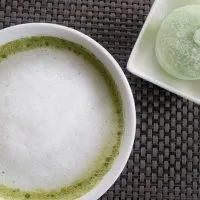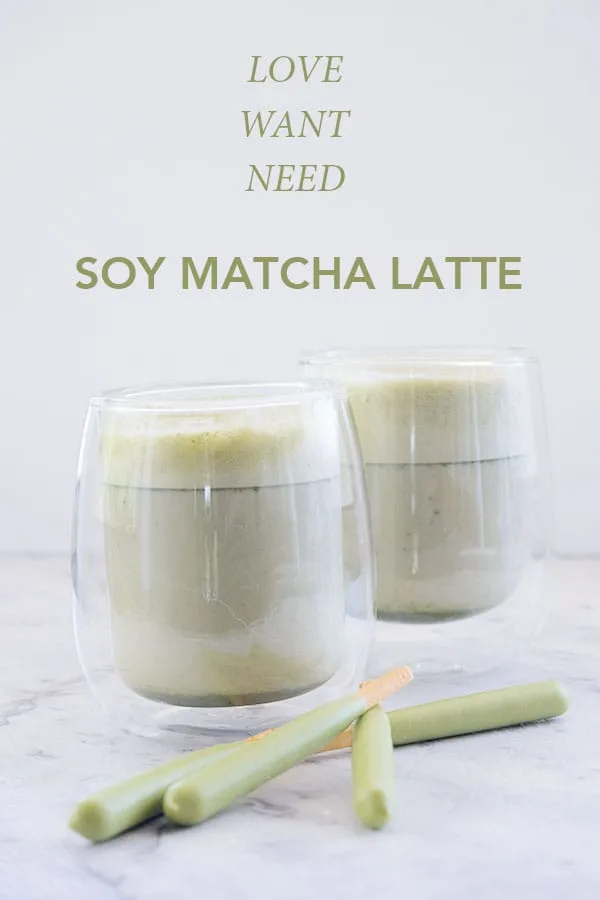Do you love the complex flavour of matcha tea but find it difficult to replicate the traditional style at home? Try this soy matcha latte for all of the flavour but none of the fuss.

I posted a while back about all my favourite Japanese teas and that while I love the pungent and slightly bitter edge to a well made traditional matcha my own efforts rarely live up to my memories of those perfect brews and tea ceremonies we enjoyed in Japan.
Disappointed with my results a few years back I used the last of my Kyoto purchased matcha powder in baking and a batch of matcha and white chocolate icecream. It hurt to do it, I’m assured it was great quality tea but my ability to make a good brew was beyond me. I’ve since paid a bit more attention in tea ceremonies, sought a few expert tips and the right tools and my results have improved but I still regularly enjoy this relaxed alternative.
You can buy many foods enhanced with the flavour and sometimes the health benefits of matcha in Japan but at home in Australia, my choices are more limited. I tried a Starbucks matcha concoction which is easily available but it didn’t quite hit the spot for me. It did inspire me to experiment with some locally available matcha brands though and come up with my own preferred rendition of the matcha latte.
Firstly I need to be clear that this is NOT a Japanese drink. What it is, is a tasty and satisfying fusion of the great matcha flavour, moderately healthy ingredients and an indulgent afternoon pick-me-up treat. One of the things I really love about Matcha is that it will give you that 3 pm pick-me-up with the crash later.

Table of Contents
Soy Matcha Latte
This delicious soy matcha latte delivers all of the flavour of matcha without the fuss.
Ingredients
- 1 t good quality matcha powder
- 1 t raw honey
- 3 T almost boiling water
- 3/4 cup organic soy milk
Instructions
1. Put the matcha powder in your cup or mug of choice. If there are small lumps sift it into the cup.
2. Add the hot water and whisk it up well until it's totally smooth. I use a chasen (Japanese bamboo whisk) but a small hand whisk will work too. My original one I purchased in Kyoto but they do need replacing if you use them regularly and I've just bought a new one online that works
3. I heat and froth my milk using a unit that came with the capsule coffee machine but you can absolutely use any frother. Daiso sell a little one for $2.80 in Australia that works perfectly well. You can even heat the milk in the microwave and use a mini hand whisk to add volume and froth.
Nutrition Information
Yield 1 Serving Size 1Amount Per ServingCalories 96Total Fat 3gSaturated Fat 0gTrans Fat 0gUnsaturated Fat 0gCholesterol 0mgSodium 91mgCarbohydrates 12gFiber 1gSugar 10gProtein 5g
I'm neither a nutritionist nor a mathematician so I use a service to calculate this nutrition information. Please use it as a guide only.
A closer look at the ingredients
Matcha
Getting quality matcha powder does matter. With most tea you steep the leaves in water, throw out the leaves and drink the water. With matcha the leaves are ground to such a fine powder that it’s incorporated into the drink and consumed. Matcha is a bit of a superfood and is loaded with antioxidents, I know all green tea has antioxident properties but I was reading recently that the level of active ingredients in matcha is more than 100x the amount.
I will just say here is that there’s a difference between quality matcha powder and ceremonial quality which is super expensive and difficult to find. Good quality matcha will be pure, often organic and have a great flavour. I bring some back from Japan when we visit but I’ve also bought it locally in Australia and I have a couple of Australian online suppliers that source from Kyoto that I’m working through trying out.
I’ve also found from experience that if your powder is at all lumpy which can happen in the humid environment of a Queensland summer or you’re not getting it to dissolve properly try sifting it into the cup.
Milk
A matcha latte isn’t a traditional Japanese drink so there’s no right milk to use, just go with your own preference. I love organic soy milk mostly because it tastes good to me but coconut milk is good too. If you prefer dairy then there is no reason not to try it here.
Water
What can you say about the water right? Well, it’s worth noting that the temperature. Water boils at is 100 degrees Celcius and the optimal temperature for matcha is 90 degrees. If you’re not a committed tea drinker with one of those fancy kettles that let you set your temperature then just turn the kettle off just before it boils or give it a couple of minutes to cool down if you miss it.
It’s not something to get too obsessive about but too hot water can scald the leaves and if you asked a Japanese tea master they would tell you it should be around 80 degrees. Too hot will make the matcha stronger and potentially a little bitter, the cooler the water added the more mild the flavour but at the same time the trade off for using it too cool is that it may not dissolve the powder as effectively.
When you’re adding some milk to make a matcha latte you want the flavour of the tea to be well developed so I find just off boiled is about right.
Sweetner
This is going to be a debatable point for some but while I do love a traditional cup of matcha which is made simply from the powdered leaves and hot water I also like my soy matcha latte with a bit of sweetener in it. Adjust it to your taste and consider using a natural sweetener like honey or agave nectar rather than sugar. I don’t use an artificial sweetener but that’s just a personal preference.
Are you feeling inspired to give it a try?
If you enjoyed this recipe please consider saving it to Pinterest. It helps us, and it helps others search for inspiration in the kitchen.

Are you a long time fan of the delicate flavour of matcha or feel inspired to give the soy matcha latte a try yourself? Let me know how you go in the comments below. If you have a cafe or coffee shop that makes a great version near you I’d love to hear about that too.